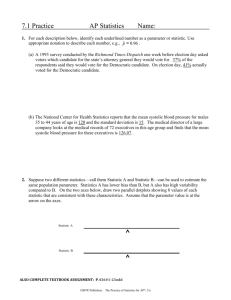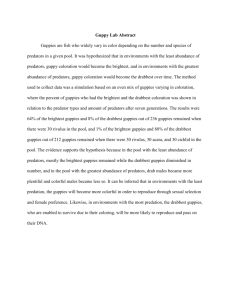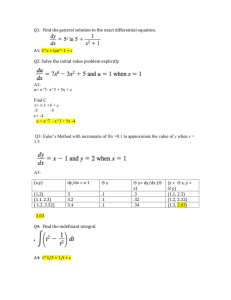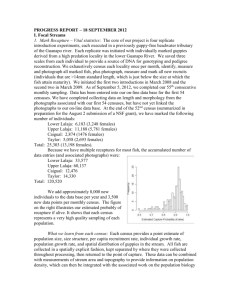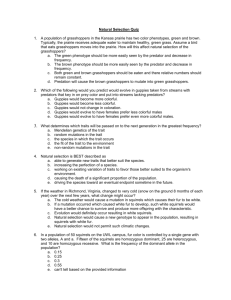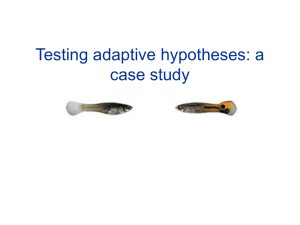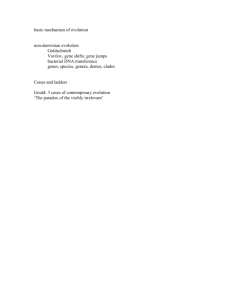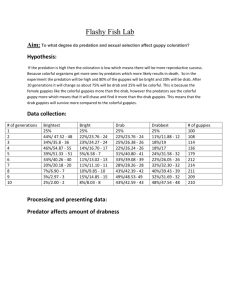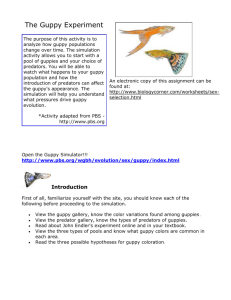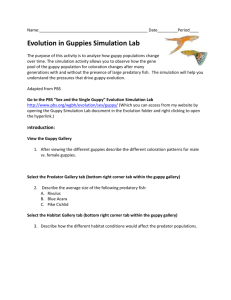PROGRESS REPORT – 18 SEPTEMBER 2012
advertisement
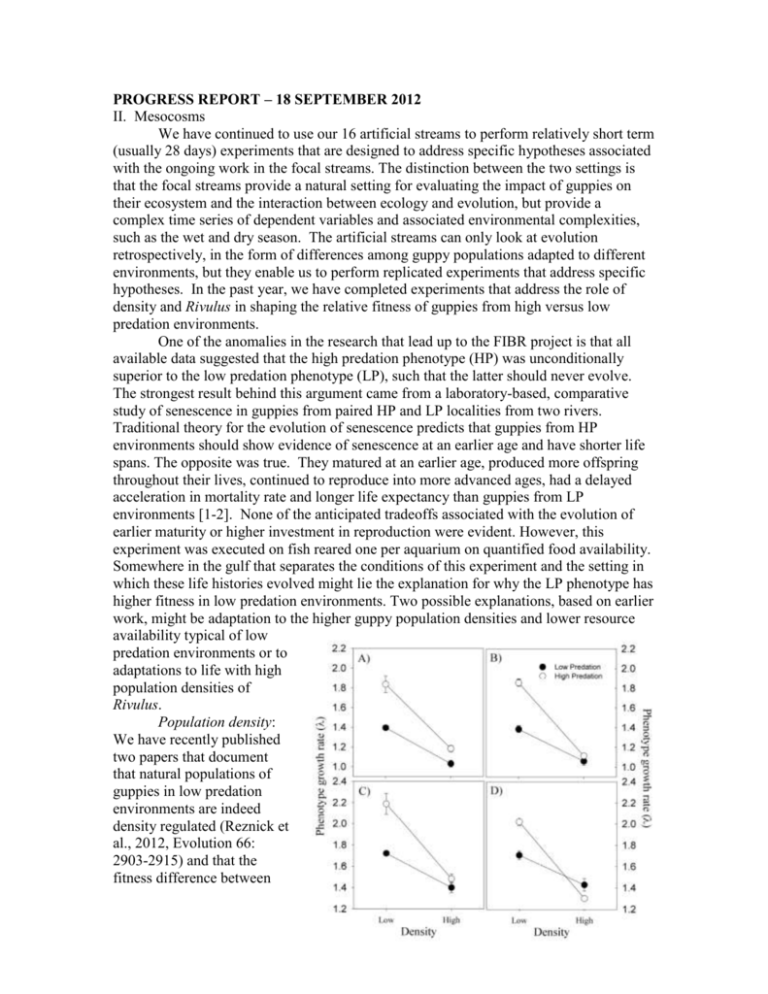
PROGRESS REPORT – 18 SEPTEMBER 2012 II. Mesocosms We have continued to use our 16 artificial streams to perform relatively short term (usually 28 days) experiments that are designed to address specific hypotheses associated with the ongoing work in the focal streams. The distinction between the two settings is that the focal streams provide a natural setting for evaluating the impact of guppies on their ecosystem and the interaction between ecology and evolution, but provide a complex time series of dependent variables and associated environmental complexities, such as the wet and dry season. The artificial streams can only look at evolution retrospectively, in the form of differences among guppy populations adapted to different environments, but they enable us to perform replicated experiments that address specific hypotheses. In the past year, we have completed experiments that address the role of density and Rivulus in shaping the relative fitness of guppies from high versus low predation environments. One of the anomalies in the research that lead up to the FIBR project is that all available data suggested that the high predation phenotype (HP) was unconditionally superior to the low predation phenotype (LP), such that the latter should never evolve. The strongest result behind this argument came from a laboratory-based, comparative study of senescence in guppies from paired HP and LP localities from two rivers. Traditional theory for the evolution of senescence predicts that guppies from HP environments should show evidence of senescence at an earlier age and have shorter life spans. The opposite was true. They matured at an earlier age, produced more offspring throughout their lives, continued to reproduce into more advanced ages, had a delayed acceleration in mortality rate and longer life expectancy than guppies from LP environments [1-2]. None of the anticipated tradeoffs associated with the evolution of earlier maturity or higher investment in reproduction were evident. However, this experiment was executed on fish reared one per aquarium on quantified food availability. Somewhere in the gulf that separates the conditions of this experiment and the setting in which these life histories evolved might lie the explanation for why the LP phenotype has higher fitness in low predation environments. Two possible explanations, based on earlier work, might be adaptation to the higher guppy population densities and lower resource availability typical of low predation environments or to adaptations to life with high population densities of Rivulus. Population density: We have recently published two papers that document that natural populations of guppies in low predation environments are indeed density regulated (Reznick et al., 2012, Evolution 66: 2903-2915) and that the fitness difference between Relative fitness of guppy phenotype guppies from HP and LP environments disappears when they are compared at population densities that are typical of low predation environments (Bassar, R. D., A. LopezSepulcre, D. Reznick and J. Travis. 2012. American Naturalist, in press). The first article was based on density manipulation experiments performed in natural streams. The second article was based on a combination of such experiments and experiments done in our artificial streams. The artificial stream experiment was a two-way design in which guppies from HP and LP environments were kept at either high or low population densities. The chosen densities represent the averages observed in an earlier study of the comparative ecology of guppies from high and low predation environments [3]. Here we illustrate a key result from that experiment, which was that the differences in fitness between HP and LP guppies disappear at high population densities. Here we illustrate the population growth rate (an index of fitness since it is a function of survival, growth rate and fecundity) of HP and LP guppies from mesocosms where they were kept at either high or low population densities. The actual values of population growth rate are derived from the application of integral population growth models [4]. The upper panels are calculated using the survival estimates from the density manipulations in natural streams, assuming equal survivorships for HP and LP guppies. The lower panels are based on survival estimated in the artificial streams. Panels A and C are for guppies from the Guanapo River. Panels B and D are for guppies from the Aripo River. Error bars are 1 standard error. Note that adaptation to density was Pimentel’s original conceptualization of an interaction between evolution and ecology, as encapsulated in his “population regulation and genetic feedback” hypothesis [5]. At that stage, Pimentel was treating the ecosystem as a black box and was implicitly assuming that high population densities were, in some unspecified way, modifying their environment and hence the kind of selection the organism experienced. Guppy-Rivulus Interactions: Palkovacs et al. [6] reported on an earlier run of this experiment. Here we designed an experiment that mimics the sequence of events associated with the invasion of a previously guppy free headwater stream by guppies derived from a high predation 1.25 environment. One treatment thus pairs 1.20 Rivulus from such a guppy free stream (Rivulus only, or RO) with HP guppies. 1.15 The next treatment pairs RO Rivulus 1.10 with guppies derived from LP 1.05 environment and hence accommodates 1.00 guppy adaptation to the new setting. The 0.95 third treatment pairs LP guppies with 0.90 Rivulus from an environment where they Rivulus Phenotype RO RO LP natural co-occur with guppies (LP Guppy Phenotype HP LP LP Rivulus) and hence accommodates adaptation of Rivulus to life with guppies. We already know from the earlier work by Matt Walsh that Rivulus life histories evolve in response to interactions with guppies and that the best explanation for this response is the indirect effect of guppies [7]. Guppies reduce the population density of Rivulus and indirectly increase per capita resource availability. Rivulus adapt to greater resource availability. Our key result, illustrated above, is that LP guppies gain a decisive fitness advantage over LP guppies when they are paired with Rivulus from an LP environment, where guppies and Rivulus are coadapted to one another. We presume that this result is a consequence of some form of ecological character divergence between guppies and Rivulus. We hope to test this hypothesis in the future. Literature Cited 1. 2. 3. 4. 5. 6. 7. Reznick, D., M. Bryant, and D. Holmes, The evolution of senescence and postreproductive lifespan in guppies (Poecilia reticulata). Plos Biology, 2006. 4(1): p. 136-143. Reznick, D.N., et al., Effect of extrinsic mortality on the evolution of senescence in guppies. Nature, 2004. 431(7012): p. 1095-1099. Reznick, D.N., M.J.I. Butler, and F.H. Rodd, Life history evolution in guppies 7: The comparative ecology of high and low predation environments. American Naturalist, 2001. 157: p. 126-140. Easterling, M.R., S.P. Ellner, and P.M. Dixon, Size-specific sensitivity: Applying a new structured population model. Ecology, 2000. 81(3): p. 694-708. Pimentel, D., Animal Population Regulation by Genetic Feedback Mechanism. American Naturalist, 1961. 95(885): p. 65-&. Palkovacs, E.P., et al., Experimental evaluation of evolution and coevolution as agents of ecosystem change in Trinidadian streams. Philosophical Transactions of the Royal Society B-Biological Sciences, 2009. 364(1523): p. 1617-1628. Walsh, M.R. and D.N. Reznick, Experimentally induced life-history evolution in a killifish in response to introduced guppies. Evolution, 2011. 65(4): p. 1021-1036.
